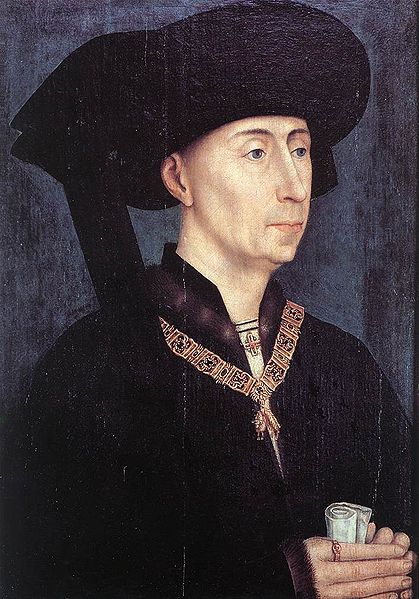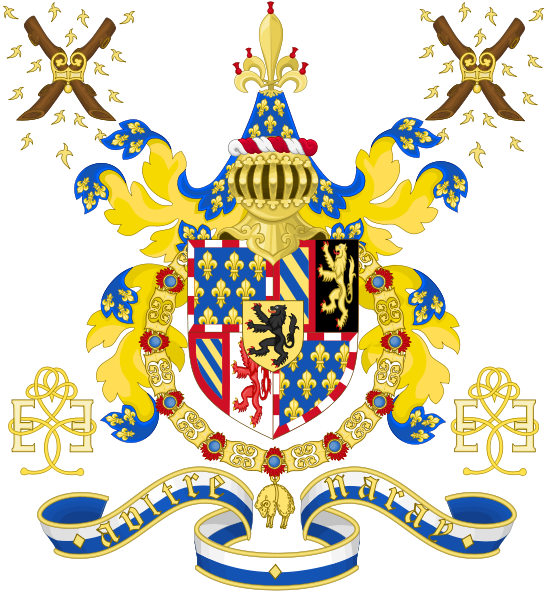<Back to Index>
- Physicist John Canton, 1718
- Painter Constant Permeke, 1886
- Duke of Burgundy Philip III the Good, 1396
PAGE SPONSOR


Philip the Good KG (French: Philippe le Bon), also Philip III, Duke of Burgundy (July 31, 1396 – June 15, 1467) was Duke of Burgundy from 1419 until his death. He was a member of a cadet line of the Valois dynasty (the then Royal family of France). During his reign Burgundy reached the height of its prosperity and prestige and became a leading center of the arts. Philip is known in history for his administrative reforms, patronage of Flemish artists such as Jan van Eyck, and the capture of Joan of Arc. During his reign he alternated between English and French alliances in an attempt to improve his dynasty's position.
Born in Dijon, he was the son of John the Fearless and Margaret of Bavaria - Straubing. On 28 January 1405, he was named Count of Charolais in appanage of his father and probably on the same day he was engaged to Michele of Valois (1395 – 1422), daughter of Charles VI of France and Isabeau of Bavaria. They were married in June 1409.
Philip subsequently married Bonne of Artois (1393 – 1425), daughter of Philip of Artois, Count of Eu, and also the widow of his uncle, Philip II, Count of Nevers, in Moulins - les - Engelbert on November 30, 1424. The latter is sometimes confused with Philip's biological aunt, also named Bonne (sister of John the Fearless, lived 1379 - 1399), in part due to the Papal Dispensation required for the marriage which made no distinction between a marital aunt and a biological aunt.
His third marriage, in Bruges on January 7, 1430 to Isabella of Portugal (1397 - December 17, 1471), daughter of John I of Portugal and Philippa of Lancaster,
produced three sons. Philip also had some eighteen illegitimate
children by various of his twenty - four documented mistresses. Philip became duke of Burgundy, count of Flanders, Artois and Franche - Comté when his father was assassinated in 1419. Philip accused Charles, the Dauphin of France and Philip's brother - in - law of planning the murder of his father which had taken place during a meeting between the two at Montereau, and so he continued to prosecute the civil war between the Burgundians and Armagnacs. In 1420 Philip allied himself with Henry V of England under the Treaty of Troyes. In 1423 the alliance was strengthened by the marriage of his sister Anne to John, Duke of Bedford, regent for Henry VI of England. In 1430 Philip's troops captured Joan of Arc at Compiègne and later handed her over to the English who orchestrated a heresy trial
against her, conducted by pro-Burgundian clerics. Despite this action
against Joan of Arc, Philip's alliance with England was broken in 1435
when Philip signed the Treaty of Arras (which
completely revoked the Treaty of Troyes) and thus recognised Charles
VII as king of France. Philip signed for a variety of reasons, one of
which may have been a desire to be recognised as the Premier Duke in
France. Philip then attacked Calais,
but this alliance with Charles was broken in 1439, with Philip
supporting the revolt of the French nobles the following year (an event
known as the Praguerie) and sheltering the Dauphin Louis. Philip generally was preoccupied with matters in his own territories and seldom was directly involved in the Hundred Years' War,
although he did play a role during a number of periods such as the
campaign against Compiegne during which his troops captured Joan of Arc.
He incorporated Namur into Burgundian territory in 1429 (March 1, by purchase from John III, Marquis of Namur), Hainault and Holland, Frisia and Zealand in 1432 (with the defeat of Countess Jacqueline in the last episode of the Hook and Cod wars); inherited the Duchies of Brabant and Limburg and the margrave of Antwerp in 1430 (on the death of his cousin Philip of Saint - Pol); and purchased Luxembourg in 1443 from Elisabeth of Bohemia, Duchess of Luxembourg. Philip also managed to ensure his illegitimate son, David, was elected Bishop of Utrecht in 1456. It is not surprising that in 1435, Philip began to style himself "Grand Duke of the West". In 1463 Philip returned some of his territory to Louis XI. That year he also created an Estates - General based
on the French model. The first meeting of the Estates - General was to
obtain a loan for a war against France and to ensure support for the
succession of his son, Charles I, to his dominions. Philip died in Bruges in 1467. Philip's court can only be described as extravagant. Despite the flourishing bourgeois culture
of Burgundy, which the court kept in close touch with, he and the
aristocrats who formed most of his inner circle retained a world - view
dominated by knightly chivalry. He declined membership in the English Order of the Garter in
1422, which could have been considered an act of treason against the
King of France, his feudal overlord. Instead in 1430 he created his own Order of the Golden Fleece, based on the Knights of the Round Table and the myth of Jason. He had no fixed capital and moved the court between various palaces, the main urban ones being Brussels, Bruges, or Lille.
He held grand feasts and other festivities, and the knights of his
Order frequently travelled throughout his territory participating in tournaments. In 1454 Philip planned a crusade against the Ottoman Empire, launching it at the Feast of the Pheasant,
but this plan never materialized. In a period from 1444 -46 he is
estimated to have spent a sum equivalent to 2% of Burgundy's main tax
income over the period, the recette génerale, with a single Italian supplier of silk and cloth of gold, Giovanni di Arrigo Arnolfini. His
court was regarded as the most splendid in Europe, and became the
accepted leader of taste and fashion, which probably helped the
Burgundian economy considerably, as Burgundian (usually Netherlandish)
luxury products became sought by the elites of other parts of Europe.
During his reign, for example, the richest English commissioners of illuminated manuscripts moved
away from English and Parisian products to those of the Netherlands, as
did other foreign buyers. Philip himself is estimated to have added six
hundred manuscripts to the ducal collection, making him by a
considerable margin the most important patron of the period. Jean Miélot was one of his secretaries, translating into French such works as Giovanni Bocaccio's Genealogia Deorum Gentilium. Philip was also a considerable patron of other arts, commissioning many tapestries (which
he tended to prefer over paintings), pieces from goldsmiths, jewellery,
and other works of art. It was during his reign that the Burgundian
chapel became the musical center of Europe, with the activity of the Burgundian School of composers and singers. Gilles Binchois, Robert Morton, and later Guillaume Dufay, the most famous composer of the 15th century, were all part of Philip's court chapel. In 1428 Jan van Eyck traveled to Portugal to paint a portrait of King John I's daughter Infanta Isabella for
Philip in advance of their marriage. With help from more experienced
Portuguese shipbuilders Philip established a shipyard in Bruges. Roger van der Weyden painted
his portrait twice on panel, of which only copies survive, wearing the
collar of the Order of the Golden Fleece. The only original van der
Weyden of Philip to survive is a superb miniature from a manuscript. The painter Hugo van der Goes, of the Flemish school, is credited with creating paintings for the church where Philip's funeral was held.